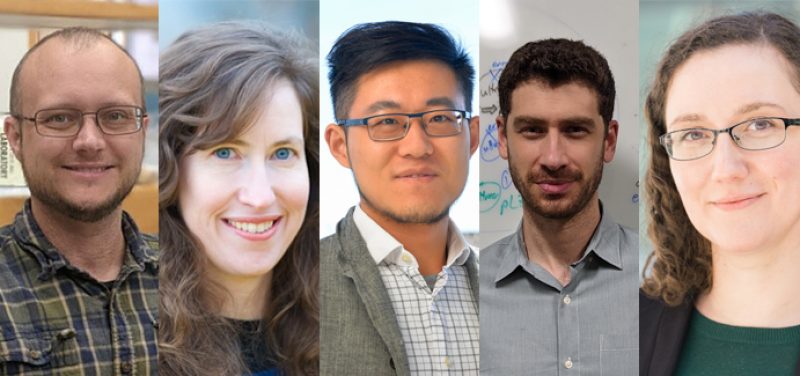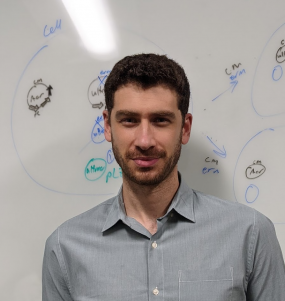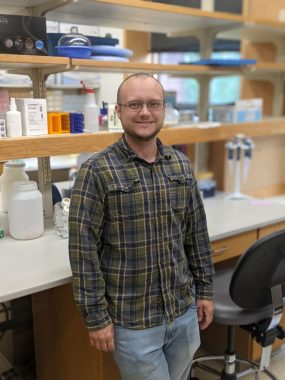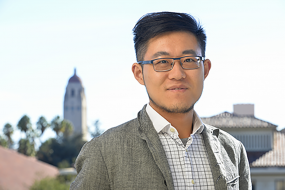
Stories

Announcing the 2021 Rita Allen Foundation Scholars
Major grants will support five pioneering early-career biomedical scientists.
The Rita Allen Foundation has named its 2021 class of Rita Allen Foundation Scholars, celebrating five early-career leaders in the biomedical sciences whose research holds exceptional promise for revealing new pathways to advance human health. The selected Scholars will receive grants of up to $110,000 annually for a maximum of five years to conduct pioneering research in the fields of cancer, immunology, and neuroscience—including investigating the role of microglia in postnatal brain development and disorders, the ability of the innate immune system to provide protection against new infections, and how proteins maintain the stability of the genome.
“We welcome this class of remarkable scientists seeking novel solutions to complex problems at the frontier of biological knowledge,” said Elizabeth Good Christopherson, President and Chief Executive Officer of the Rita Allen Foundation. “As we are seeing the importance of decades of biomedical research in confronting the COVID-19 pandemic, the fundamental research these scientists are leading will lay the groundwork for tomorrow’s transformative medicine.”
Since 1976, the Rita Allen Foundation has invested in more than 190 biomedical scientists at the early stages of their careers, enabling them to pursue research directions with above-average risk and promise. Scholars have gone on to make fundamental contributions to biomedical research—including discoveries that have fueled gene therapy and gene editing, innovative treatments for cancer and neurological disorders, and new ways of studying neurons. They have won recognition including the Nobel Prize in Physiology or Medicine, the National Medal of Science, the Wolf Prize in Medicine, the Lasker-Koshland Award for Special Achievement in Medical Science, and the Breakthrough Prize in Life Sciences.
The 2021 Scholars were nominated by research institutions in the United States and selected by the Rita Allen Foundation’s Scientific Advisory Committee of leading scientists and clinicians.
The 2021 Rita Allen Foundation Award in Pain Scholars will be announced later this year.
The members of the 2021 class of Rita Allen Foundation Scholars are:
Joshua Modell, Johns Hopkins University (Milton E. Cassel Scholar)
Lucas Cheadle, Cold Spring Harbor Laboratory
Ellen Foxman, Yale University
Guosong Hong, Stanford University
Viviana Risca, The Rockefeller University

Joshua Modell, Johns Hopkins University (Milton E. Cassel Scholar)
Assistant Professor, Department of Molecular Biology and Genetics
B.S., Duke University
Ph.D., Massachusetts Institute of Technology
Joshua Modell has been designated the Milton E. Cassel Scholar for the 2021 class of Rita Allen Foundation Scholars. This special award honors the memory of a longtime President of the Rita Allen Foundation who passed away in 2004.
CRISPR technologies have led to revolutionary new modes of genetic inquiry in the basic sciences, and they are in development as therapeutics for many genetic diseases. Less is known about how CRISPR systems function in nature, where they provide bacteria with adaptive immunity against viruses and plasmids. My laboratory seeks to understand how these systems interact with the biology of their bacterial hosts and viral targets, and how their activity is regulated to provide strong immunity against viruses while preventing autoimmunity.
How did you enter this career path? Was there anyone or anything that particularly inspired you?
I always loved puzzles as a child and fell in love with biology as a senior in high school, thanks to an incredible biology teacher, Ms. Howard. I thought I would study cancer genomics until my third rotation in graduate school, when I became fascinated by bacteria and how they process information and respond to stress. Throughout my career, I have struggled with feelings of insecurity and wondered whether academia was for me. I am still here thanks to the honest feedback from my mentors who assured me that many scientists, and even some of the best ones, have similar doubts.
What is your favorite science-related book?
A Genetic Switch by Mark Ptashne—part textbook, part molecular thrill ride.
What will funding from the Rita Allen Foundation allow you to do?
Funding from the Rita Allen Foundation will allow me to explore how CRISPR systems contribute to virulence in human pathogens, like Streptococcus pyogenes and Staphylococcus aureus. These studies will enable us to better understand how antibiotic resistance evolves and inform new antimicrobial strategies, including those involving natural and engineered phages.

Lucas Cheadle, Cold Spring Harbor Laboratory
Assistant Professor
B.A., Smith College
Ph.D., Yale University
The brain is one of the most exquisitely complex networks in the known universe, and its precise connectivity is established through a convergence of genetic and environmental influences (i.e., nature and nurture, respectively). While many of the genetic factors that drive early stages of embryonic brain development are known, we still lack a comprehensive understanding of how the environment—in the form of sensory experiences—shapes neural circuits in the developing brain. We unexpectedly discovered that sensory experiences engage microglia, a unique class of brain-resident immune cells, to promote the refinement of synaptic connections between neurons early in postnatal life. Based upon this finding, the Cheadle lab combines functional, structural, and genomics approaches to systematically disentangle the mechanisms microglia and neurons use to interact with one another to facilitate postnatal brain development, and to understand how impairments in microglial function contribute to neurodevelopmental disorders.
What will funding from the Rita Allen Foundation allow you to do?
Funding from the Rita Allen Foundation will allow us to take a uniquely multidisciplinary approach to studying the role of neuro-immune interactions in the brain. We will use this funding to establish a novel live-imaging paradigm to visualize interactions between microglia and synapses at nanometer scale in the brains of live mice, in an awake state, as they experience a diverse array of visual stimuli. By performing these live-imaging studies in mice with disrupted cytokine signaling, we will define the molecular and spatio-temporal dynamics of microglia-neuron communication in vivo. In parallel, we will adapt genomics approaches to profile changes in gene expression that occur in microglia in response to experience. Overall, Rita Allen funding will be pivotal in allowing us to apply cutting-edge technologies to answer translationally relevant questions about the roles of microglia in the brain.
How did you enter this career path? Was there anyone or anything that particularly inspired you?
My path toward a career in neuroscience began with an early interest in the ability of the brain to process information about the world around it—an interest that was reflected by my first spoken word, “eye.” As I matured, this interest in the brain expanded to an interest in cognition (what is that inner voice inside my head that defines my thoughts and actions, and why do I think and behave differently from others?) and in the psychiatric disorders that arise when cognition is disrupted. A once-in-a-lifetime opportunity to leave my rural high school in the Chickasaw Nation of southeastern Oklahoma to attend the Oklahoma School of Science and Mathematics, a competitive boarding school for high school students with a talent for research and discovery, cemented my path toward a career in neuroscience research.

Ellen Foxman, Yale University
Assistant Professor, Laboratory Medicine and Immunobiology
B.S., Yale University
Ph.D., Stanford University School of Medicine
M.D., Stanford University School of Medicine
Our first line of defense against harmful infections is known as innate immunity—an inborn system of protective mechanisms that guards against harmful viruses or bacteria, even when the body has never encountered the infection before. Many individuals infected with dangerous viruses such as influenza or coronavirus can recover quickly with only mild symptoms, even without immunity from prior exposure or vaccination, because of these defenses. The Foxman lab studies the biology of innate immune responses in tissues that are not traditionally considered part of the immune system, such as the cells that form the lining of the nasal passages and lung airways. Understanding how innate immunity is regulated in these tissues could help answer unsolved questions in infectious diseases—why the same viral infection can be asymptomatic in one person, but lead to a serious illness in another; or, on a larger scale, why certain viruses spread through families or communities at certain times but not others.
What will funding from the Rita Allen Foundation allow you to do?
Over the past several years, there has been increasing evidence suggesting that an individual’s infection history may help protect against future exposures not only by inducing traditional memory responses of the immune system, but also by recalibrating innate immune responses within the body’s tissues. For example, recent experiments in our lab showed that exposure to the common cold virus could temporarily protect against unrelated viruses, such as influenza or COVID-19, through effects on innate immunity within airway cells. Funding from the Rita Allen Foundation will allow us to study new unexplored questions about how an individual’s infection history impacts innate immunity.
How did you enter this career path? Was there anyone or anything that particularly inspired you?
I was inspired to pursue biomedical research by my father, who was a wonderful physician and encouraged my intellectual curiosity from an early age. My father also always emphasized how important it is to keep sight of why you are pursuing your career path, and the value of working to make a positive impact on the lives of others.
What is your favorite science-related book?
That’s a difficult one because there are so many! I have particularly enjoyed books by Oliver Sacks, which delve deeply into the lives and inner workings of the brains of specific patients he met during his career as a neurologist. He explores ideas about how our biology shapes our perceptions, interactions, and humanity.

Guosong Hong, Stanford University
Assistant Professor, Materials Science and Engineering
B.S., Peking University
Ph.D., Stanford University
Our research aims to study how the brain changes at the level of single neurons over time as well as the circuits encompassing these neurons. The brain is a dynamically changing structure. The time-dependent evolution of neural circuits during brain development—learning and memory, and aging—occurs over many years and in many different brain regions. However, this evolution involves physiological changes that must be quantified at the millisecond and micrometer scales of individual neurons. A substantial challenge in understanding the dynamically changing brain arises from the spatiotemporal mismatch between the neural activity of interest and the available tools to study it. Therefore, we aim to fill the knowledge gap by developing novel bioelectronic and biophotonic tools to study the long-term evolution of neural circuits during neurodegeneration. The knowledge obtained therein will offer therapeutic strategies for devastating diseases such as Alzheimer’s, thereby improving life quality for the families affected and society as a whole.
What will funding from the Rita Allen Foundation allow you to do?
The generous support from the Rita Allen Foundation will allow my lab to address a key question in neuroscience research—can we chronically follow a small group of identified neurons in a living subject, manipulating and recording the activity as the subject engages in different activities? This ability, which requires a chronically stable bidirectional neural interface, will help answer an array of additional important questions in neuroscience for understanding the dynamic evolution of neural circuits during learning and memory, aging and neurodegeneration, and neural development.
How did you enter this career path? Was there anyone or anything that particularly inspired you?
Originally trained as a physical chemist, I have expanded my research beyond chemistry by developing new tools to facilitate the work of neurobiologists. I have long been fascinated by how new discoveries in the physical sciences have pushed the boundaries of our knowledge in neurobiology. As an example, Ramón y Cajal’s exquisite drawing of the brain, which ushered in the modern era of neuroscience, was enabled only because of the unexpected precipitation kinetics between soluble silver and chromate precursor salts.
What is your favorite science-related book?
My favorite science-related book is A Crack in Creation: Gene Editing and the Unthinkable Power to Control Evolution by Jennifer Doudna and Samuel Sternberg. When I read it in my postdoctoral years, it transformed the way I viewed science and technology. The book portrays the thrilling adventure of how one of biology’s greatest discoveries led to the invention of the incredibly powerful and game-changing technology of gene editing. As Doudna and Sternberg write in their final sentence, “Every time we unlock one of nature’s secrets, it signals the end of one experiment, and the beginning of many others.”

Viviana Risca, The Rockefeller University
Assistant Professor; Biochemistry, Biophysics, Chemical Biology, and Structural Biology
B.S., Stanford University
Ph.D., University of California, Berkeley
In order to fit into our cells, the human genome is packaged by proteins that protect it from breaks and cancer-causing mutations. These proteins also help cells maintain cell identity by suppressing the expression of genes that belong to other cell types. My lab is studying one such protein, called macroH2A, which has been shown to suppress several types of cancer. I recently developed a cutting-edge method for mapping the folding of DNA within cells. We are using this method in combination with biochemical studies of DNA wrapped around purified proteins to study the structural mechanisms that macroH2A uses to regulate gene expression. MacroH2A also interacts with PARP1, a major cancer drug target involved in DNA repair and regulation of transcription, and we hope that these insights will inform future innovations in targeted therapy.
What will funding from the Rita Allen Foundation allow you to do?
Funding from the Rita Allen Foundation will allow us to do a deep dive into the molecular mechanisms through which the macroH2A protein regulates the folding of DNA. By having the resources to develop new tools and approaches to address these questions both in vitro and in vivo (in cells), we hope to gain a more comprehensive understanding of this protein’s function—discovering what features of genome organization are necessary and/or sufficient.
How did you enter this career path? Was there anyone or anything that particularly inspired you?
My long-standing interest in how cells store and process the information in our genomes started with a ninth-grade biology lecture by Ms. Judy Ferris about the central dogma of molecular biology. I still remember the day—it was spring in the suburbs of New York where I grew up. Learning how tRNAs and the ribosome translate nucleotide sequences into amino acid sequences immediately convinced me that I had to learn more about how biological systems function. Since that day, I have been inspired and encouraged by kind mentors who welcomed me into their labs, including Daniel Eichinger, Carter Bancroft, Steven Block, Upinder Singh, Dan Fletcher, Will Greenleaf, and Aaron Straight. I am incredibly lucky to spend my time studying fundamental questions about genome organization and function at Rockefeller, and hope to inspire the next generation of scientists through teaching and mentorship.